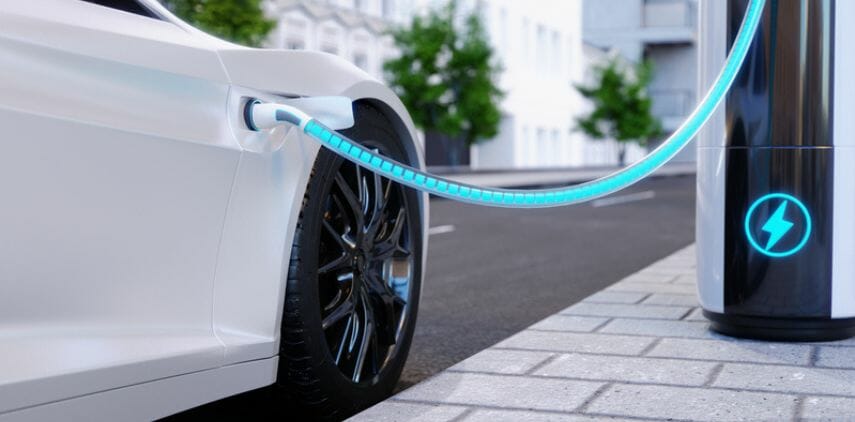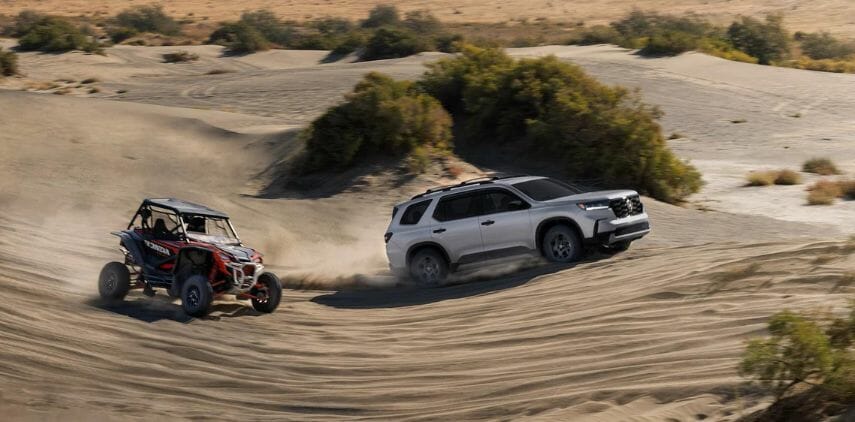Overview
The average driver has heard of 4-wheel drive, but fewer have heard of a 4-stroke engine. There’s a good reason: 2-stroke engines are rarely used on the road nowadays and are more common in smaller vehicles like dirt bikes. Learning the difference may not make a difference to a midsize SUV driver, but it certainly will to an automotive or engine enthusiast.
Table of Contents
A Quick Overview of Engines
For those not experienced with engines, the nuances between 2-stroke and 4-stroke engines can be confusing at best. To best understand the difference between these two engine configurations, it’s helpful to know the basics of how engines work.
The crankshaft is what allows the wheels on a vehicle to turn. To provide power to the crankshaft, the engine undergoes a process that’s sometimes referred to as a combustion cycle. Every non-electric engine design, at its most basic, uses the same mechanism to power the vehicle: it pulls fuel and air into the combustion chamber, compresses them, and then ignites the fuel, which both provides power to the crankshaft and shoves the piston downward (thus allowing the used fuel to escape).
Much as the name implies, the primary difference between 2-stroke and 4-stroke engines is how many piston strikes are required to complete a power cycle. With a 2-stroke engine, the engine requires only two piston strokes to get the power it needs:
- As air and fuel move through the chamber, the piston moves upward, compressing the air and fuel within the cylinder.
- The fuel is ignited (typically by the spark plug in gasoline engines and mere heat generation in diesel engines), pushing the piston back down and allowing the used fuel to escape.
A 4-stroke engine, however, requires a few more steps for a full power cycle. With a 4-stroke engine, it takes four up-and-down movements of the piston to provide power to the engine:
- The piston moves downward, drawing the fuel and air into the cylinder.
- The piston moves upward, pressing the fuel and air up at the top of the cylinder. (This is sometimes called the “compression stroke.”)
- Something ignites the fuel, turning the engine’s crankshaft and forcing the piston back down (also known as the “power stroke”). In gasoline engines, this is triggered by the spark plug; diesel engines, on the other hand, ignite the fuel by simply generating heat.
- The piston moves upward again, pushing the used fuel through the exhaust pipe. (This move is sometimes called the “exhaust stroke.”)
Although the underlying combustion process is essentially the same for both types of engines, this methodology has earned 4-stroke engines the somewhat-crude mnemonic of “suck, squeeze, bang, blow.”
Where These Engines Are Used
Almost every 4-wheeled vehicle uses a 4-stroke engine, like SUVs, cars, and heavyweight vehicles. These are also widespread in other types of vehicles, like motorcycles, some types of trains, and even lawnmowers. 2-stroke engines were once far more commonplace in 4-wheeled vehicles, but their environmental impact and overall fiddliness saw them largely phased out by the end of the 1960s.
2-stroke engines are essentially a relic of the road; however, that does not mean they’re a relic of the past. They’ve been continuously developed over the last few decades and are frequently used in small engines. In the context of vehicles, they’re usually included in dirt bikes, small boats, snowmobiles, and go-karts. They are also a staple of certain power tools, like leaf blowers and snow blowers.
Because 2-stroke engines have a certain appeal to some drivers, there have occasionally been efforts to bring 2-stroke engines back to the world of 4-wheel vehicles. A prime example was the 2009 debut of the engine company EcoMotors, which sought to develop an environmentally-friendly 2-stroke engine. However, the project appears to have sputtered out by the late 2010s, with the company later closing down.
The Benefits and Drawbacks of Two-Stroke vs. Four-Stroke Engines
Somebody more familiar with debates between hybrid SUVs and electric SUVs might not understand the discussion on 2-stroke and 4-stroke engines; after all, only one type is frequently used on the road. But for those who take “off-roading” at its most literal and regularly operate boats, snowmobiles, or dirt bikes, there’s a tangible difference between these engines. Let’s take a look at the benefits and drawbacks of both.
The Pros of 2-Stroke Engines
2-stroke engines often receive praise for their agility and versatility. Some features make them a logical choice for small vehicles and power tools.
- Speed: Because 2-stroke engines only require two piston strikes to complete the power cycle, they provide more power at a faster rate.
- Weight: 2-stroke engines aren’t as heavy as 4-stroke engines. This makes them more appealing to bikers and operators of other lightweight vehicles.
- Easy to repair: 2-stroke engines are less complicated than their 4-stroke counterparts, which makes them easier to repair. (Hands-on automotive fans may appreciate this.)
The Cons of 2-Stroke Engines
It’s easy to wonder why a simple, lightweight engine was dropped in favor of a complicated, heavy one. However, 2-stroke engines have some fairly serious downsides.
- More frequent maintenance and repair: 2-stroke engines aren’t as durable as their complex 4-stroke cousins. They require far more active maintenance and will break down more often without it.
- Environmental impact: Unlike 4-stroke engines, which don’t need additives in their fuel, fuel for a 2-stroke engine must have oil mixed in to work properly. Subsequently, the exhaust valves of 2-stroke engines expel pollutants that are far more harmful to the environment, which has drawn plenty of criticism.
The Pros of 4-Stroke Engines
It’s pretty easy to see why 4-stroke engines became commonplace in cars. Compared to 2-stroke engines, 4-stroke engines have a slew of benefits.
- Consistent power: While 2-stroke engines provide power more quickly, they don’t always give the same amount of power consistently. 4-stroke engines, on the other hand, provide consistent amounts of power.
- More resilient: The way 4-stroke engines are built makes them less likely to break down when used.
- More environmentally friendly: Unlike 2-stroke engines, 4-stroke engines don’t require oil in their fuel, so their emissions don’t contain any oil. This makes them the more environmentally friendly choice.
The Cons of 4-Stroke Engines
While 4-stroke engines are becoming the norm across the world of engines, that doesn’t make them the perfect choice. Some auto enthusiasts prefer 2-stroke engines because of the drawbacks of 4-stroke engines.
- Less power, more slowly: 4-stroke engines take four piston strikes to finish a power cycle, so they don’t provide as much power as quickly as 2-stroke engines.
- More complex: A 4-stroke engine has far more moving parts than a 2-stroke engine, which makes them more challenging to repair when they break down.
- Heavier than 2-stroke engines: The additional parts of a 4-stroke engine don’t just make it more complex; they also add extra weight. This is less desirable for smaller vehicles and lightweight power tools.
Despite their cons, 4-stroke engines have ultimately become standardized across many vehicles, with even some smaller engines transitioning to 4-stroke models. Dirt bikers, for example, often face the choice of choosing a bike with a 2-stroke or 4-stroke engine. While dirt bikes have historically been fitted with 2-stroke engines, many manufacturers have equipped their newer models with 4-stroke engines for better reliability and to meet vehicle emission standards.
SUViews Can Assist in Your Vehicle Search
You may be unable to find an SUV with a 2-stroke engine, but that doesn’t mean there are no SUVs that fit your needs. At SUViews, we offer plenty of advice and reviews on SUVs that will help you choose the best SUV for you. Of course, even luxury SUVs with 4-stroke engines may not provide a similar thrill as a dirt bike with a powerful 2-stroke engine, but as the saying goes, different strokes for different folks.






